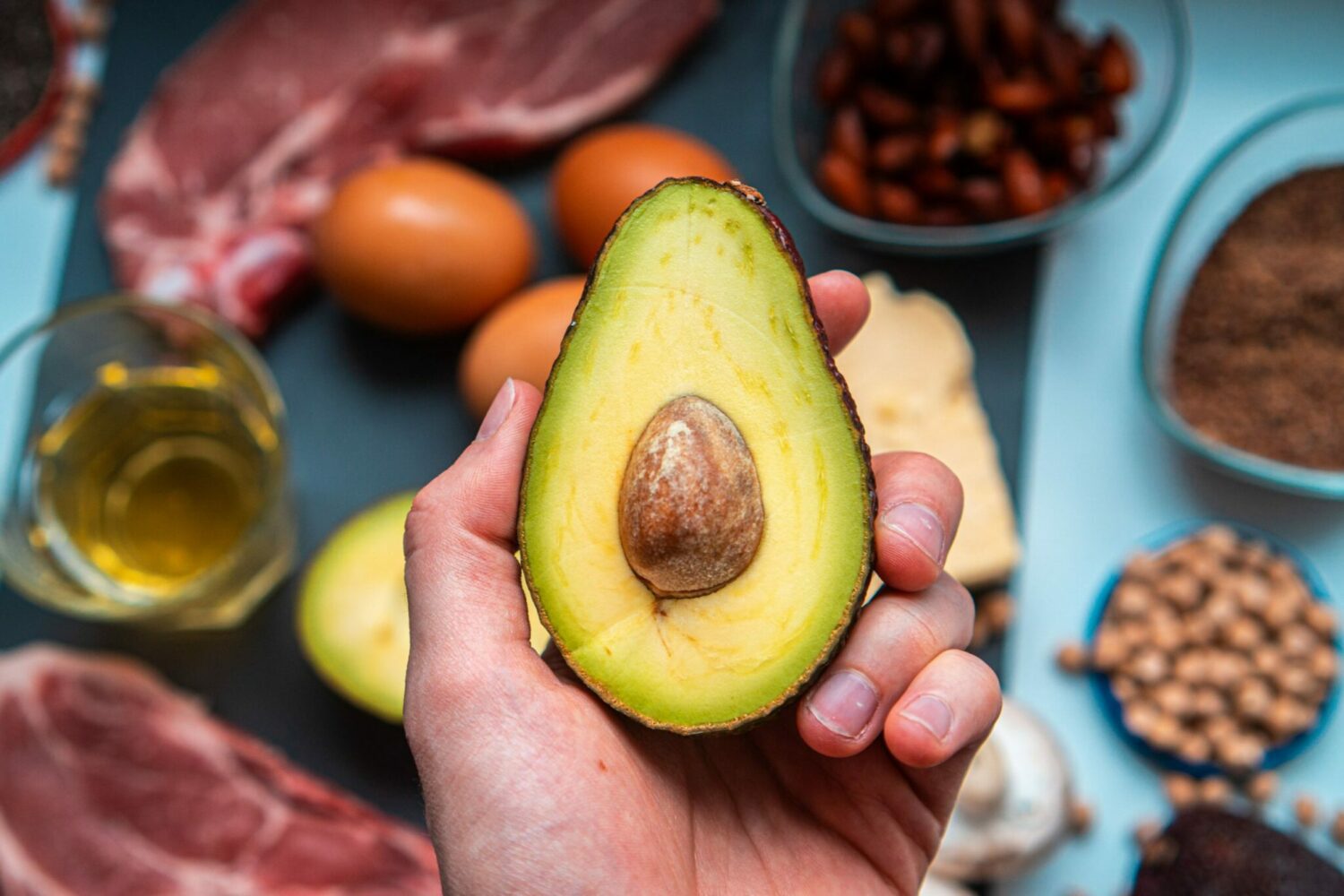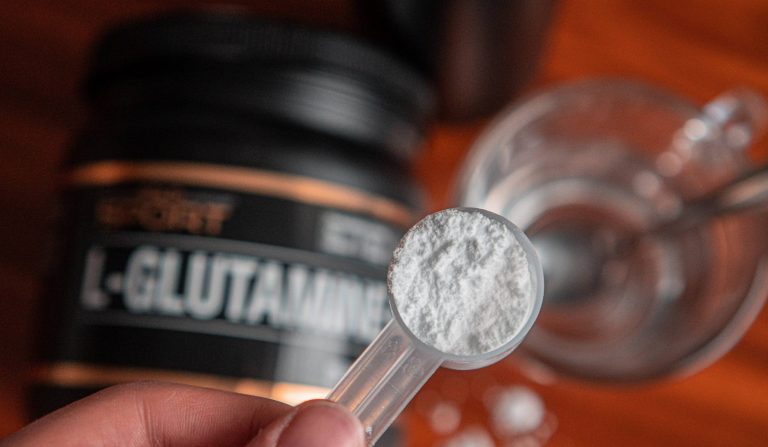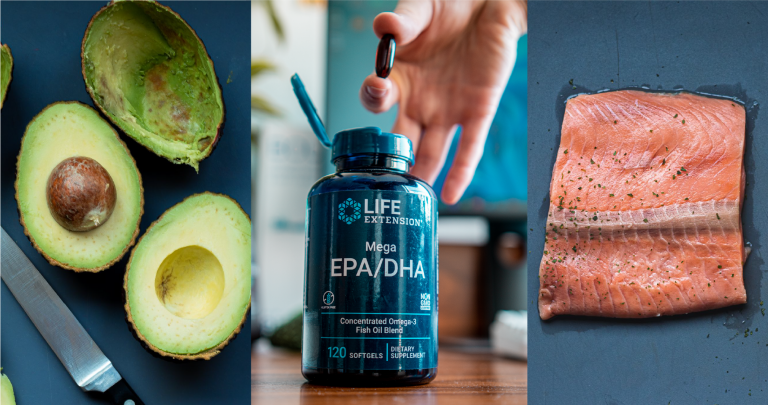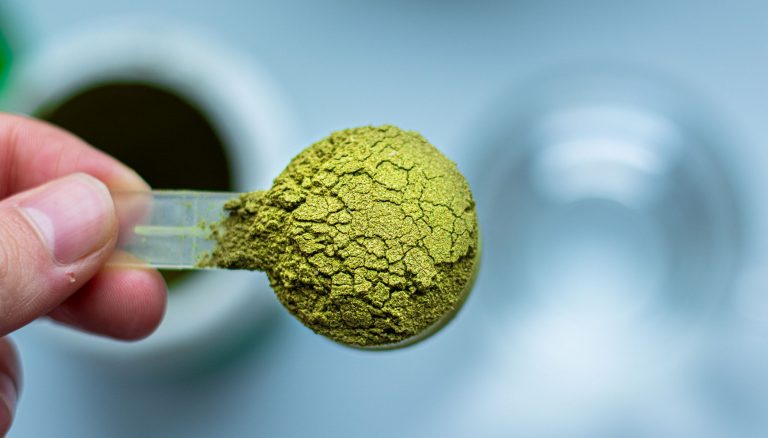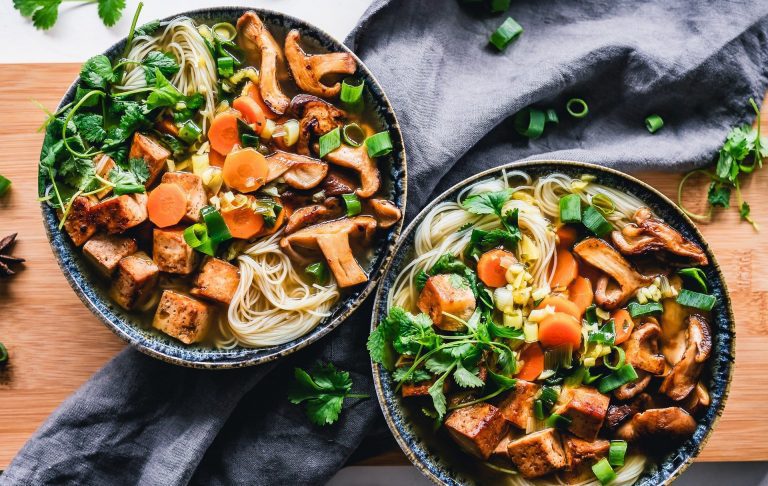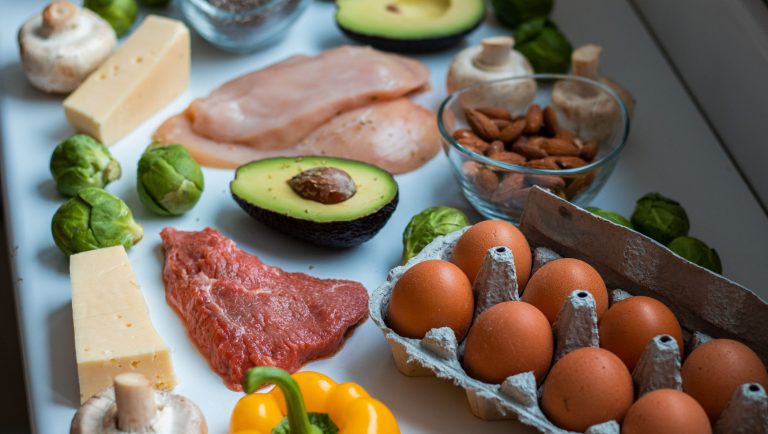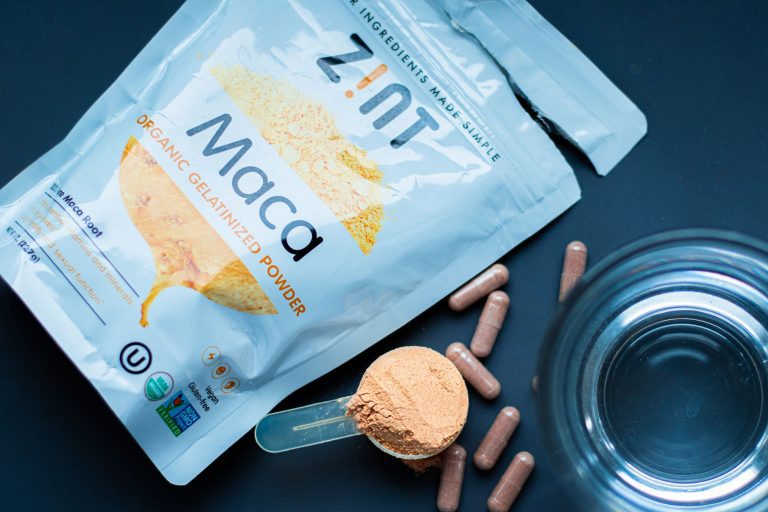Top 14 High Fat Healthy Foods for LCHF or Keto Diet
You don’t have to be on the Keto or LCHF diet to eat these. These are our favorite, nutrient-loaded high fat healthy foods, which just happen to be suitable for low-carb diets. We will discover the power of avocados, salmon, and olive oil. This goes beyond omega 3, into more nutrients, fiber, and fat-soluble vitamins and how these can help us stay young, healthy, and energetic.
High Fat Healthy Foods
What we know for sure is that omega-3-rich foods are healthy. We are talking about your olive (oil), avocado (oil), flax seeds, walnuts, salmon, and seafood. But also, many fatty foods contain high amounts of vitamin A and E, potent antioxidants.
What you may find surprising in this list is how we incorporated some saturated fats. Although some saturated fat can be bad for heart health (margarine, salami, deep-fried chicken wings, creamers), saturated fat is crucial for the structural integrity of the brain, temperature, and hormone regulation. We’ll check grass-fed beef, butter, and coconut oil from the saturated side.
1. Avocado
Avocados are one of the cleanest sources of fat. Yes, it’s a fruit. It is the most versatile, fully fat-loaded powerhouse of nutrients. I can’t find a diet it doesn’t fit in (except carnivore). Keto, Paleo, Vegan, Mediterranean, it could sneak inside.
One raw avocado provides you with 227 calories, 77% of which come from fat. (1) Yep, it’s fatty. The good news is, it is loaded with healthy fats like omega-3 fatty acids.
Avocados and omega 3’s come with a myriad of health benefits such as supporting brain health and function, boosting mood, improving heart health, fueling your body, and helping with skin & bone regeneration. (2)
Besides that, avocados high amount of fiber, providing up to 9.2 grams per avocado. Fiber helps us regulate blood sugar, promotes satiety, improves digestion, etc. (3)
Avocado is also pretty rich in Potassium (689 mg or 20% DV), Folate (121 mcg, 30% DV), and Vitamin K (28.6 mcg, 36% DV) per avocado. Potassium plays a role in fluid balance maintenance, folate is important for growth, development and red blood cell formation and vitamin K helps with blood clotting and building strong bones.
There you go, make sure to eat some more guacamole, squash an avocado and spread it on your whole-wheat toast, or just slice it up into beautiful cubes and add it to a veggie salad. Enjoy!
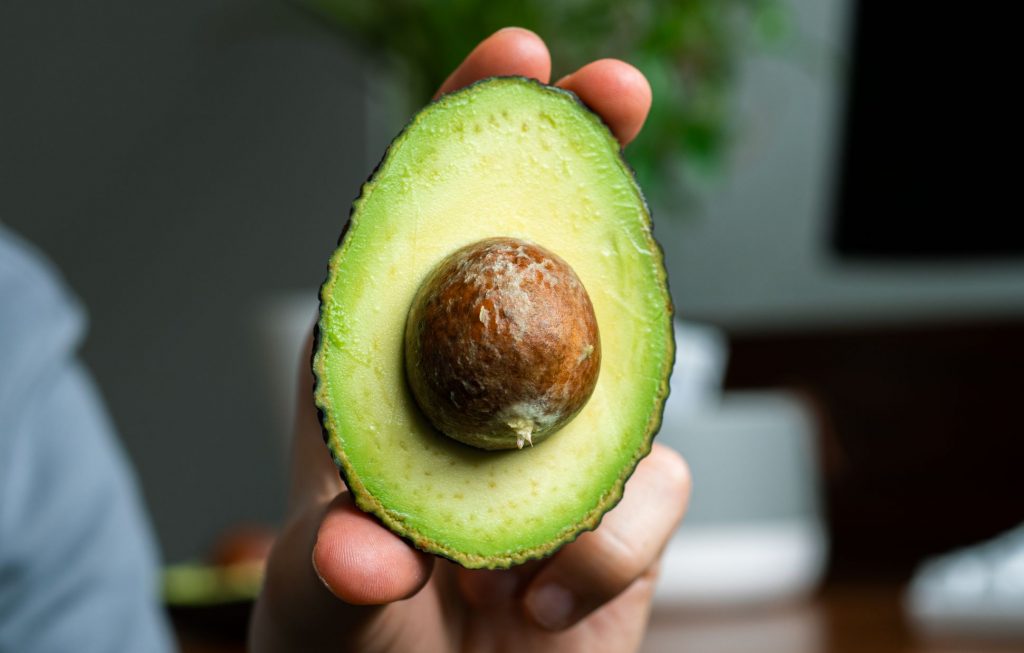
2. Grass-Fed Beef
Grass-fed beef isn’t just a trendy food, it’s a powerhouse of nutrients. Suitable for a carnivore (of course), keto, paleo, and Atkins diet. Many athletes swear by a piece of grass-fed steak, alongside some veggies, let’s see why.
Per 4 oz. or 113 grams of raw, grass-fed beef you get around 224 calories. Wow, what a bomb. It has a ton of protein, providing you with up to 22 grams (per portion 113g) which helps with muscle growth, development, and regeneration. (4)
It contains 14 grams of fats, meaning around 126 kcal comes from fat itself. It has a ratio of around 60% to 40% fat-to-protein and 1% carbs. The ratio of monounsaturated to saturated fats is approximately 1-1, with 5% polyunsaturated fats. (5)
It contains a lot of phosphorus, important for strong teeth and bones. It is rich in Iron and Zinc, hence why it supports muscle growth. Iron is involved in oxygen transport, the creation of hemoglobin while zinc plays a role in cell development, growth, regeneration, etc.
Grass-fed beef is also rich in fat-soluble vitamins like vitamin A and vitamin E. Vitamin A is important for vision, immunity, and reproduction (6) Vitamin E is a powerful antioxidant involved in skin regeneration, which fights oxidative stress. (7)
Last and most important, compared to grain-fed beef, grass-fed is way richer in healthy fats, namely omega-3 fatty acids which have important anti-inflammatory properties.
3. Raw, Whole Milk
I remember drinking real, raw, and whole milk when I was young. The farm guy would just bring it in a DIY plastic bottle, you could smell the freshness of real milk. Matter of fact, it was still warm when we got it.
Nowadays, there are so many – plant milk, skim milk, powder milk, etc. We wonder if milk is healthy and why our stomach cramps. Well, if you’re lactose intolerant, the bad news, is you can only enjoy plant milk.
Real milk is not non-fat, sugary, stripped milk. It’s milk that provides a lot of calories, is loaded with healthy fats and minerals, and has tons of protein. Per 1 cup of whole, raw milk we get around 146 kcal, with 12,8 g carbs, 7.9 g fat, and 7.9 g protein. (8)
There is a protein in the colostrum (mother’s milk) known as Lactoferrin, important for optimal gut microbiome development and lining in babies, hence why sucking milk is very important. (9)
Raw milk contains many microorganisms that play a major role in gut development and support health. Compared to pasteurized milk, it also contains antimicrobials, important for controlling harmful microbes. (10) As shown in the Raw Milk Institute, raw and whole milk contain many enzymes, probiotics, and compounds important for gut health, immunity, and digestion. (11)
In terms of nutrients, whole milk contains an abundance of Vitamin D (24% DV), Riboflavin (B3) (26% DV), Vitamin B12 (18% DV), Calcium (28% DV), Phosphorus (22% DV) and Potassium (10% DV). (12)
B-vitamins are also crucial in energy production, cell metabolism, growth, regeneration, and health.
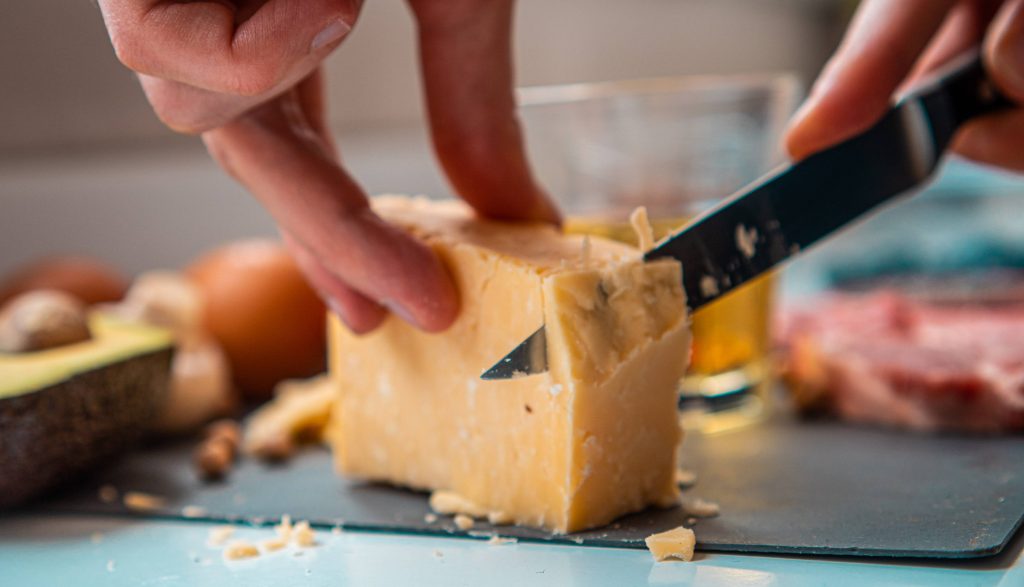
4. Cottage Cheese
There is no shortage of bodybuilders hearing and incorporating cottage cheese into their diets. But why? It’s a low-calorie, but pretty high-protein option. Contains some healthy fats, and is almost zero carbs, good right?
Per 100 grams of cottage cheese, you get 98 kcal. Surprisingly, the ratio of carbs-fat protein is 13%-39%-48%, which is impressive. You’d get 4.3 g of fat, and a whopping 11.1 g of protein. (14)
Cottage cheese is also abundant in minerals like calcium (83 mg, 8%), phosphorus (159 mg, 16% DV), sodium (364 mg, 15% DV), and Selenium (9.7 mcg, 14% DV). (15) These minerals are important for maintaining strong bones, fighting oxidative stress, and maintaining fluid balance. Cottage cheese has also zinc, copper, and choline in it which can help with cognition.
Cottage cheese is also high in casein and glutamine. The first one is an important protein that is slowly absorbed over a longer timeframe (great for dinner), so your muscles munch on it longer. Glutamine helps with gut lining health, immunity, and muscle-building too.
If you haven’t tried it yet, make yourself some protein-enriched pancakes (oats, protein, eggs, banana) and add some cottage cheese, flax seeds, and avocado on top. Enjoy!
5. Flax Seeds (Oil)
Flax seeds or flaxseed oil are excellent sources of omega-3 fatty acids, which have important anti-inflammatory properties. They also support brain function, and cardiovascular health, lower triglycerides, and maintain the structural integrity of the nervous system. (16) (17) Make me smarter aye.
Per 100 grams of flax seeds, you get 534 kcal, 18.3 g of protein, a whopping 42.2 g of fat, and 28.9 carbohydrates. (18) Of course, you’ll aim for 5-10 grams, not 100, just saying. They’re pretty rich in fiber which supports digestion and feeds the good gut bacteria.
Flax seeds contain a little quantity, but a large variety of different vitamins and minerals like manganese, zinc, copper, iron, magnesium, vitamin B 6, folate, thiamine, etc.
Another impressive fact is, flaxseed oil contains a lot of ALA, an important omega3 fatty acid. (19)
Alpha-linolenic acid is the best omega-3 source for plant-based eaters. It plays a major role in energy metabolism, digestion, nutrient absorption, turning food into energy, etc. It also has potent anti-inflammatory properties too. (20)
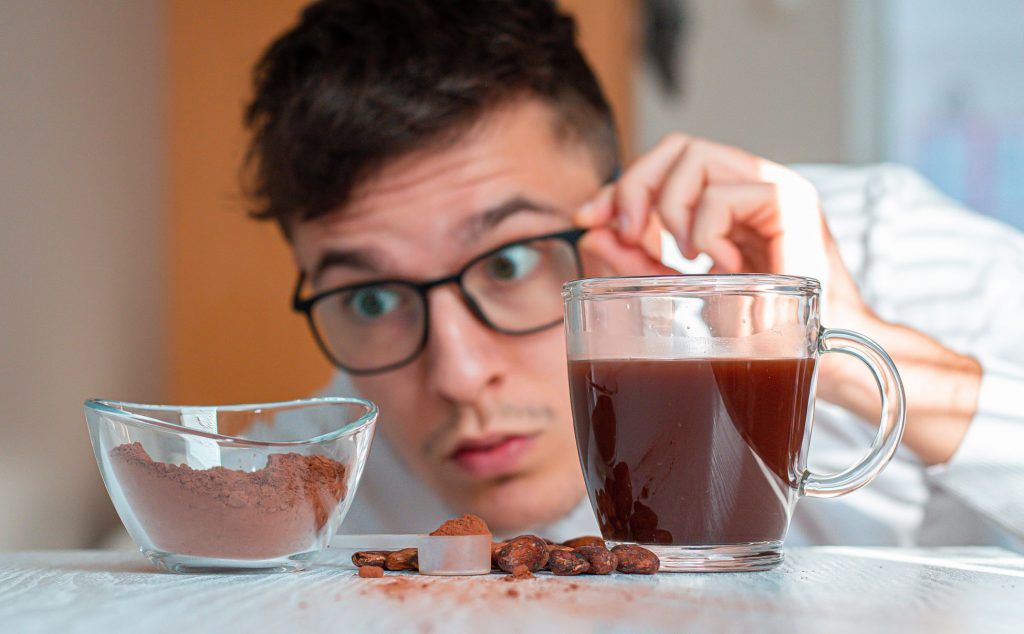
6. Dark Chocolate, Cacao
Down to my favorite. Is there anything better than hearing the dark, rich, chocolate flavor you loved is not a vice anymore? Unless you combine it with tons of sugar it is, but otherwise, coffee and cocoa are one of the most frequently consumed, potent antioxidants on the planet.
Chocolate above 65-85% of cacao is considered Dark Chocolate, depending on who you ask. I’d aim for a combo that you find satisfying, and trust me 95% cacao doesn’t taste anything like chocolate. So aim for 65-86% cacao, low sugar, high fiber option.
Per one portion of 28 grams (I eat more) you’d get 12 g of fat, 13 g of carbs, and 2.2 g of protein. Not bad. Fat makes up approximately 65% of total calories, which is amazing. (21)
- The superpower of Cacao lies in its polyphenol abundance. These are powerful antioxidants that makeup 12-18%, of cacao beans’ dry weight. (22)
- It can increase HDL (the good cholesterol), and contains more polyphenols compared to white chocolate, plus chocolate fatty acids can reduce LDL oxidation. (23)
- Dark chocolate is rich in especially Iron (19% DV), Magnesium (15% DV), Zinc (9% DV) per serving of 28 g. It also contains some caffeine too, good for cognition. (24) Cocoa is rich in fiber, which can additionally help with digestion, so that’s a bonus.
Pro Tip
Aim for low-sugar, high cacao content of 65-85% for a healthier version of dark chocolate. Also, cocoa is roasted beans powder, and cacao is not roasted. The latter one has much more antioxidants, fiber, and magnesium. It’s also a bit more sour, bitter, and earthy.
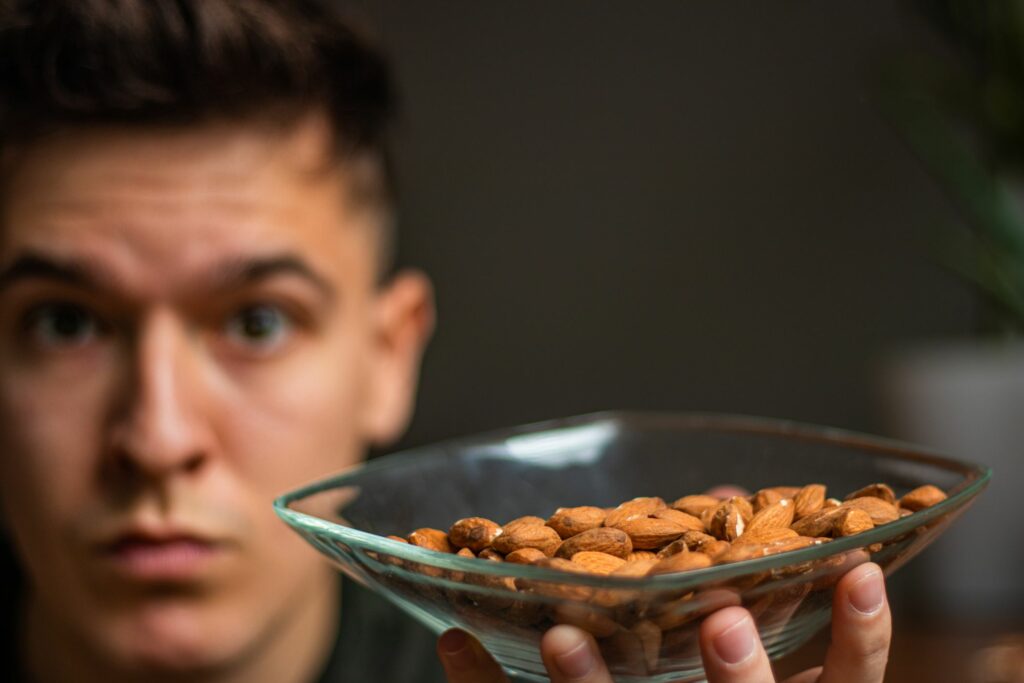
7. Almonds & Walnuts
Nuts are a great source of fiber and healthy fats. Almonds and walnuts are my top two options, but others will do good as well. By the way, nuts are pretty high in calories, so don’t eat a whole jar of peanut butter, please.
Almonds are 72% fat and provide up to 575 kcal per 100 grams. (25) Walnuts are even fattier, coming at 83% fat, providing up to 654 kcal per 100 grams. (26)
Almonds are pretty rich in Vitamin E (26.2 mg, 131% DV), Riboflavin (1 mg, 60% DV), Niacin (3.4 mg, 17% DV), Magnesium (268 mg, 67% DV), Manganese (2.3 mcg, 114% DV) and about 20-30 % DV of Potassium, Iron, Zinc, and Calcium. These numbers are impressive, but note that this is per 100 grams, which is a lot of nuts. (27)
Walnuts on the other side, are rich in Thiamin (0.3 mg, 23% DV), Vitamin B6 (0.5 mg, 27% DV), Manganese (3.4 mg, 171% DV), Phosphorus (346 mg, 35% DV), Magnesium (158 mg, 40% DV) and other minerals, per 100 grams. (28)
The good thing is, that nuts, especially walnuts are very rich in omega 3 fatty acids. These act anti-inflammatory, support brain function, maintain structural integrity, are involved in metabolism, and support heart health.
Nuts are known to also improve cholesterol profile, reduce inflammation, reduce the risk of cardiovascular disease, and support weight loss. (29)
8. Extra Virgin Olive Oil
Extra virgin olive oil is one of the healthiest fatty foods you can incorporate into your diet. Don’t overdo the oils, because they’re calorie-dense. However, if you want to spread some on your salad, olive oil is the one to go for.
It is rich in monounsaturated fats and has a ton of antioxidants, the most important one, it is loaded with omega-3 fatty acids. These translate to heart health, reducing inflammation, boosting brain function, etc.
Not a surprise, its 100% fat, and has zero carbs and proteins. It is pretty rich in vitamin E and Vitamin K, the same ones as in avocado. Important minerals for skin health, blood clotting, bone strength, plus they’re potent antioxidants. (30)
- Olive oil has a ton of oleic acid, which is a monounsaturated fat important for reducing oxidative stress and inflammation. (31)
- It was also shown to improve regeneration, and have beneficial effects on autoimmune and infectious diseases, and cancer. (32)
Extra research: Olive Oil on Neuroprotection
- Not to even mention the potential neuroprotective effects of olive oil. Most of these have to do with Olive oil’s high polyphenolic and antioxidant content which has anti-microbial, anti-carcinogenic, and anti-inflammatory effects. (33) Indeed, reducing brain inflammation is important for preventing neurodegeneration.
- It is no secret that the Mediterranean diet is associated with neuroprotection (or prevention of neurodegenerative diseases). Research even shows that partially, the consumption of extra-virgin olive oil might be one of brains longevity weapons of the Mediterraneans. (34)
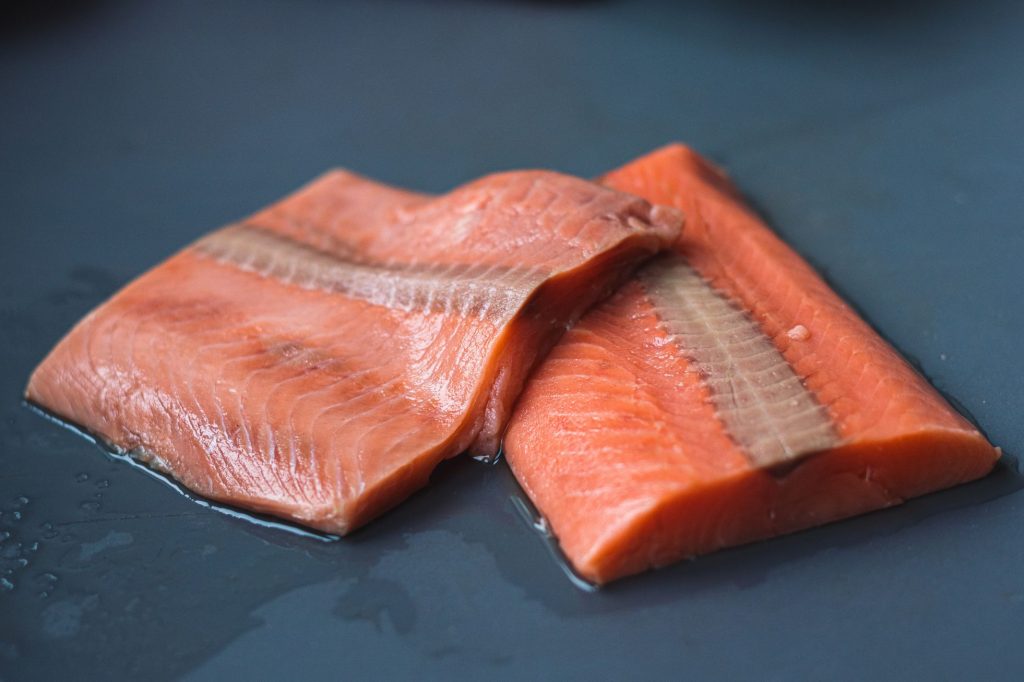
9. Wild-Caught Fatty Salmon
One of the healthiest fish you can eat is Salmon. No surprise. Why? It is loaded with omega-3 fatty acids. Salmon is also pretty rich in protein, and healthy fats.
It’s made up of 60% protein, and 40% fat. Per half a fillet (154 g) we get 280 kcal, 39.2 g of protein, zero carbs, and 12.5 g of total fat. There is very little saturated fat, and it’s mostly monounsaturated (4.2 g) and polyunsaturated fat (5.0 g) in salmon. (35)
When it comes to nutrients, it’s nothing short of a nutrient powerhouse. Per half a fillet of salmon you’d get DV of 78% Niacin (vitamin B3), 73% Vitamin B6, 44% of Riboflavin, 28% Thiamin, and 30% Pantothenic acid. Man, that’s a lot of vitamins. Salmon is also pretty rich in Selenium, Phosphorus, Copper, and Potassium, too. (36)
The abundance of omega-3 in salmon helps with heart health, blood pressure, inflammation, brain function, etc. We’ve already spoken about the potent antioxidant effects.
The power of salmon lies in astaxanthin, one of the most powerful antioxidants. Saying it only fights oxidative stress is not enough. It is involved in neuroprotection, heart health, inflammation, and more (37)
10. Beef Liver
Grass-fed beef Liver is undoubtedly one of the most nutrient-packed foods I know of. Surprisingly, the macros are very fitness-friendly. It isn’t so calorie-dense, for the nutrients it provides. Per 3 oz. we get 153 kcal, high protein at 23 g, and low fat at 4 g.
Raw Liver contains a ton of B vitamins, especially high in vitamin B12 providing up to a whopping 988% DV or 59.3 mcg per 100 grams. It is also abundant in Riboflavin, Niacin, vitamin B6, Folate, and Pantothenic Acid, bringing 60-75% DV and a whopping 162% for Riboflavin. (38) Now that’s nutrient-dense.
In the mineral department, the Liver excels at Phosphorus (39% DV), Zinc (27% DV), Selenium (57% DV), Iron (27% DV) and waits for it…. An impressive 488% DV of Copper. (39)
Due to the high amount of vitamin B12 and iron, it can reduce anemia risk, and increase oxygen transport by increasing red blood cells and hemoglobin production.
Beef liver is also rich in cholesterol, providing up to 275 mg or 92% per 100 grams. Cholesterol is important lipoprotein that plays a major role in the production of testosterone, it’s part of the brain’s (cell membrane) structure, synthesizes vitamin D, creates bile acid for digestion, and maintains fluidity balance. (40)
Pro Tip
Do not overcook beef liver, or it will taste how you think it tastes. When overdone, livers become sticky, less palatable, and hard to chew. Instead, watch some “YouTube Experts” cooking the liver for 5 mins on each side. Enjoy!
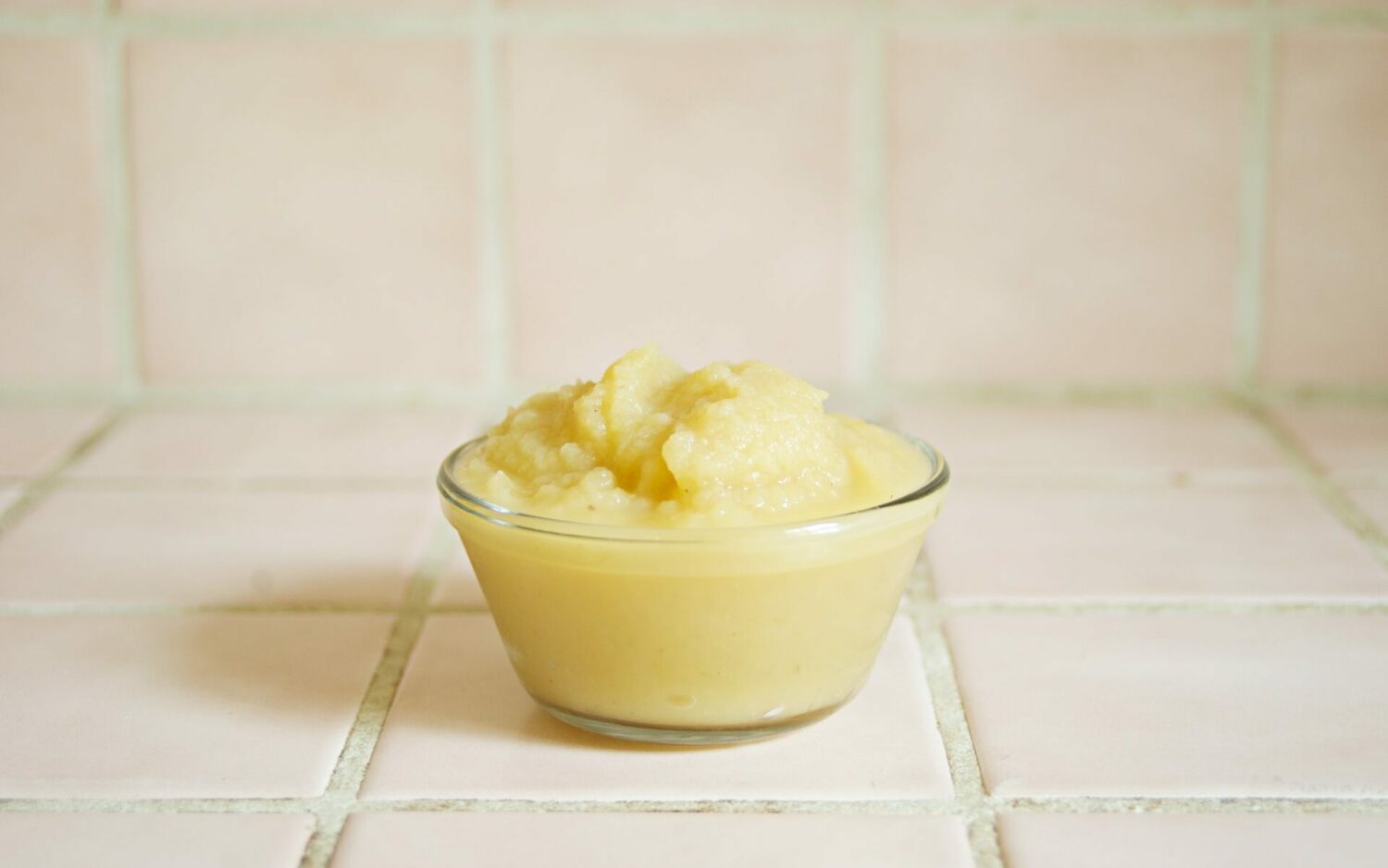
11. Grass-Fed Butter
Ever tried Bulletproof coffee? Grass-fed butter is the main ingredient. Here’s Why:
Grass-fed butter is pretty rich in CLA, an important type of fat found in animal products and dairy. GF butter is one of the best sources to get CLA from. Why do you want it?
Conjugated Linoleic Acid is omega 6 FA known to speed up fat loss, at least in keto-practitioners. CLA isn’t just powerful for body composition, helping you lose fat. It has also been shown to improve glycogen regeneration and support immune function and bone mineralization. (41)
As with keto, the goal of CLA is to speed up the transition to ketosis. It activates lipolysis, a process that breaks down fats and reduces fatty acid accumulation. In other words, it accelerates fat loss.
As with other oils, it is no secret it’s a 100% fat type of thing. It contains 10% DV of Vitamin A, or 500 IU, per 14 grams. (42)
Vitamin A is important in supporting vision, eye health, reproductive health, and immunity. It also supports the work of different organs in the body and helps them develop and grow.
Grass-fed butter is also a good fat to cook some of your meals, but also a delicious addition to soup, omelet, shrimp salad, and of course, coffee.
It is a good source of vitamin K2, an important fat-soluble vitamin. Vitamin K2 plays an important role, it helps regulate bone metabolism, keeps our bones strong, and regulates vitamin D absorption and calcium levels. (43)
Pro Tip
You’d want to aim for grass-fed butter really and leave grain-fed ones. The first version has more vitamins, omega 3’s, and fewer additives and antibiotics. This means better anti-inflammatory properties and richer nutrition.
12. Whole Eggs
Remember when your grandma feared eggs because egg yolks increase cholesterol levels? That was a generation before. Have you seen bodybuilders swearing by an egg whites liquid at the supermarket? That’s this generation.
While overdoing eggs, eating too much is of course (as with anything) not a good thing, you’ll be surprised how nutrient-packed and rich in healthy fats the egg yolk is. Raw eggs can contain Salmonella, so please don’t try to mimic Rocky Balboa and drink them in a shake. Cook them properly.
Eggs are 62% fats, 36% Protein, and only 2% carbs. (44)
Per 1 large egg (50 g) we get around 72 calories, so a good 3-egg omelet will give you around 200 kcal, and sufficient protein.
Eggs are also pretty rich in healthy fats, and fat-soluble vitamins like vitamin D, vitamin A, and vitamin E. These play a major role in development, growth, regeneration, bone and muscle strength, skin health, vision support, and fighting inflammation.
Another superpower nutrient in eggs is choline. The richest source of choline is beef liver, and guess who takes the second spot? Hard-boiled eggs, yap. Providing up to 147 mg, per 1 large egg (or 27% DV). (45)
Choline is considered an essential nutrient and plays a role in metabolism. It is involved in neurotransmitter production, liver function, cardiovascular function, brain function, and memory. (46) (47)
Eggs are also rich in:
- Monounsaturated fats; can improve cholesterol profile, raise HDL and lower LDL, and reduce inflammation
- B-vitamins, especially B12, B5, and B2, essential for metabolism, energy, and health
- Proteins, one of the best non-meat, wide diversity amino acid sources with high bioavailability
- Cholesterol is crucial for brain structure & integrity, bile acids production, Testosterone production, and vitamin D absorption.
Pro Tip
Hard-boiled eggs contain more protein than raw or scrambled ones. Read that one again. It’s also a lower-calorie option and may preserve more of the nutrients and healthy fats in it.
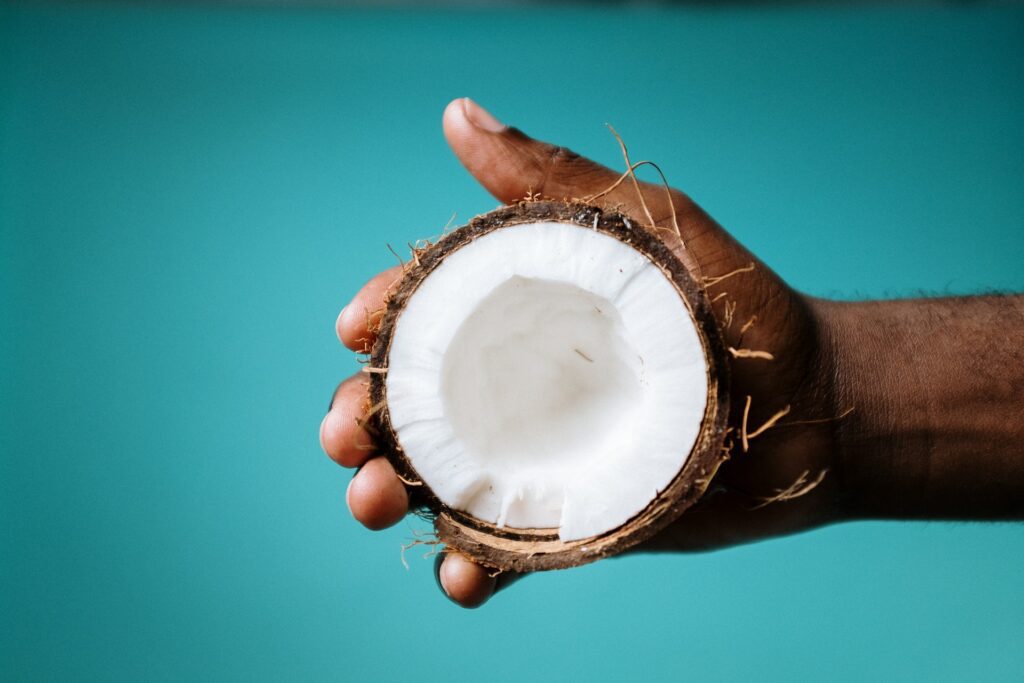
13. Coconut Oil
A food usually demonized for its high content of saturated fat has now become the superfood plant-based eaters and keto practitioners swear by. Funny how trends change. What’s so special about coconut oil?
Coconut oil has proven beneficial in some instances, especially when it comes to brain function, fat loss, and skin health. Funny for a saturated fat food, right?
It seems that coconut oil contains MCT or medium-chain triglycerides which can potentially help us shift into ketosis faster, and with faster ketosis induction – comes fewer side effects of transition. (48) (49) MCTs are also more efficient in the speed by which they’re broken down for energy, may aid in weight-loss, plus they’ve shown some neuroprotective benefits too. (50) (51) (52)
- Per 14 grams or 1 tbsp of coconut oil, you’d get 13 g of fat, and zero of everything else. (53)
- Lauric acid, which is present in coconut oil is known for its potent antifungal and antimicrobial effects. (54)
- Last but not least, coconut oil is one of the most frequently used, natural fats for skin health in cosmetics. Moisturizers, cleansers, creams, scrubs, you name it. It’s because of its ability to hydrate the skin and protect against infections, toxins, and allergens. (55)
14. Chia Seeds
If you’re into superfoods, there’s no chance you’ve missed chia seeds. It’s a great addition to puddings, oatmeal, yogurts, and even fruit bowls.
Per 100 g of chia seeds, you get 486 kcal, 16.5 g protein, 30.7 g fat, and 42.1 g carbs. The impressive thing is, as many seeds, chia contains a ton of fiber, providing up to 34.4 g per 100 g. (56)
Chia seeds are pretty rich in minerals such as Iron, Calcium, Magnesium, Zinc, and Phosphorus. It is also a good source of some B-vitamins, essential for energy metabolism.
Chia: Extra research on Chia’s Antioxidants
Chia’s superpower lies in its high omega 3 content, which we should know by now it fights inflammation. Specifically, it is rich in Alpha-linolenic acid. ALA is a potent antioxidant that fights oxidative stress and acts anti-inflammatory, plus it increases Glutathione production, a potent antioxidant too.
- In terms of antioxidants, Chia contains caffeic acid, quercetin, and Kaempferol. So the main superpower? Potent antioxidant.
- The high fiber content of chia might also improve digestion, and improve glycemic and lipid profiles which come with potential cardiovascular benefits. (57)
- Research also shows the potential use of Chia for anxiety and depression, and also for hypertension, and control of blood sugar. (58)
When it comes to weight maintenance and fat loss, chia does wonders. Not literally, but the high-fat, high-fiber combo makes you satiated, which makes you feel fuller faster. This type of soluble fiber absorbs water, which is easily seen if you soak chia in milk or water, it’ll grow the next day.
Go soak yourself some chia in milk, and add some protein, berries, and oats. You’ll thank me later.
Conclusion
Healthy fats are crucial in development, brain function, heart health, and hormone production. Many Keto-friendly foods have a ton of healthy fats and soluble vitamins like A, K, D, & E. The healthy fat foods are Salmon, Dark Chocolate, Eggs, Avocado, Beef Liver, Grass-Fed Beef and Butter, Chia Seeds, Coconut Oil, Olive Oil, Walnuts, Raw Whole Milk, Cottage Cheese, and Flax Seeds (Oil). Healthy fats, especially omega 3’s are potent antioxidants that fight inflammation.

